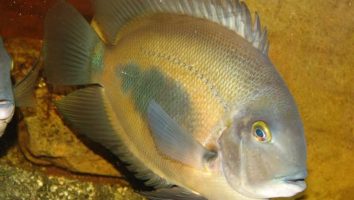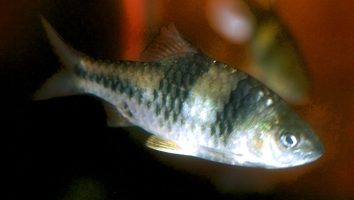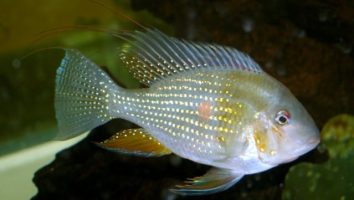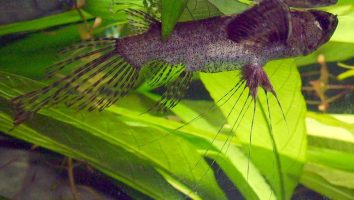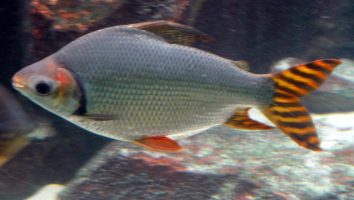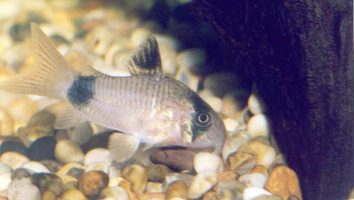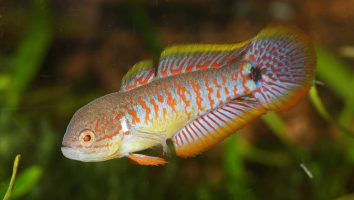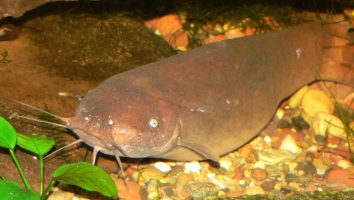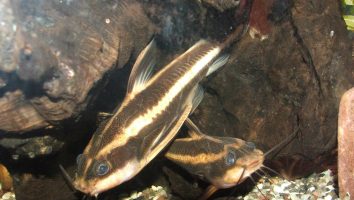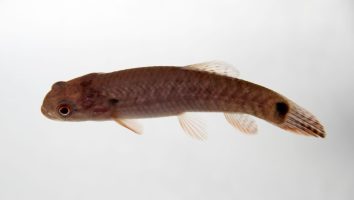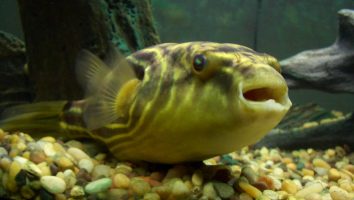The flying fox fish is a beautiful and unique freshwater fish that’s perfect for the intermediate fishkeeper.
They’re not too difficult to care for, but they do require a little more attention than some of the other fish on this list.
In this guide, we’ll teach you everything you need to know about flying fox fish care. You’ll learn about their diet, tank mates, lifespan, and more!
Table of contents
Species overview
The flying fox (scientific name: Epalzeorhynchos kalopterus) is a type of freshwater fish that’s native to Southeast Asia. They are commonly found in Thailand, Laos, Cambodia, and Vietnam.
Flying foxes prefer slow-moving water with a lot of vegetation. This could be in the form of a River, Lake, or even a swamp.
These fish are known to be very peaceful and are often kept in community tanks. They are a schooling fish, so it’s best to keep them in groups of at least 6.
The flying fox is a very popular fish in the aquarium trade and is known for its unique appearance. It has a long, black body with orange stripes running down the sides.
Appearance
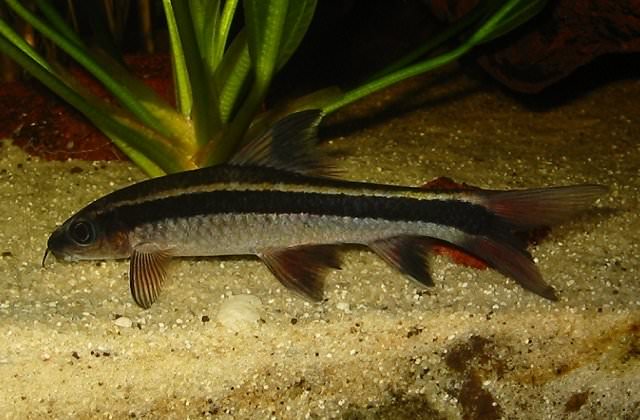
The first thing you’ll notice about this freshwater fish is their unique coloration. The body of the fish is a dark brown or black. This color gradually fades into a lighter brown or tan on their belly.
What really makes them stand out though is the large orange or red stripe that goes from the base of their head all the way to the end of their tail.
This stripe is broken up into a series of smaller orange or red spots. These spots get larger as they get closer to the tail of the fish.
The fins on a Flying Fox are fairly standard for a small barb. The dorsal fin starts almost halfway back on their body and looks like half a shell. When this fish swims quickly this fin gets tucked back a bit (this makes them look like little red torpedoes).
Their anal and pectoral fins are moderately sized. Flying Foxes have a forked caudal fin that is symmetrical on the top and bottom.
Each of their fins is slightly translucent.
Lifespan
The typical lifespan of a flying fox fish is around five years. Of course, this can differ based on the individual fish and the care it receives.
For instance, if the flying fox fish is kept in a subpar tank with poor water quality then it likely won’t live as long as one that’s kept in pristine conditions.
Likewise, a flying fox fish that’s constantly stressed out by aggressive tank mates probably won’t live as long as one that’s in a calm and peaceful tank.
Size
The average size of a flying fox fish is around 2.5 inches (6.4 cm). Some fish keepers have reported that their flying fox fish have reached lengths of 4 inches (10 cm), but this is relatively rare.
Tank
Tank Size
The minimum tank size for a flying fox fish is 20 gallons. If you want to keep more than one flying fox fish in your tank, you’ll need to add an additional 10 gallons for each fish.
While 20 gallons is the minimum, we recommend going with a larger tank if you can. This will give your fish more space to swim and explore. It will also give you more options when it comes to tank mates.
Water Parameters
The flying fox fish is a tropical freshwater fish that is native to the rivers of Southeast Asia. In the wild, they prefer slow-moving waters with plenty of vegetation.
They’re not terribly picky when it comes to water parameters, but they do prefer slightly acidic water with a temperature between 70 and 80 degrees Fahrenheit.
- Water Temperature: 70 to 80 degrees Fahrenheit
- pH Levels: 6.0 to 7.0
- Water Hardness: 2 to 12 dGH
- Alkalinity Levels: 4 to 8 dKH
What To Put In Their Tank
If you want to keep flying foxes in an aquarium, there are a few things you need to take into account. First and foremost, these fish need a ton of space to swim.
A general rule of thumb is to have at least 50 gallons for a single fish. But, if you want to keep a group of them then you need to increase the size of the tank exponentially.
These fish are also known to be jumpers, so you need to make sure the tank is covered. A lot of people will use a screen top for this, but we prefer a full hood with a light since it helps reduce evaporation (which can be a problem in larger tanks).
As for decorations, it’s best to keep things on the minimal side. A few pieces of driftwood or some rocks should suffice. These fish like to have a lot of open space to swim, so don’t go overboard.
The substrate is another important consideration. Flying foxes are known to sift through the substrate looking for food, so you need to make sure it’s something that won’t hurt them. We recommend a fine gravel or sand.
Common Diseases
While flying foxes are a rather hardy species, they’re not immune to disease. The most common illness that these fish experience is ich.
Ich is a very common parasitic infection that can quickly become serious if it’s not dealt with. The most obvious sign of this disease is the series of white spots that will begin to cover the body of your fish.
There are plenty of other potential diseases that can affect this species as well, but they’re not as common.
Another thing to look out for is infection from cuts. The most common cause of this is keeping your flying fox in a tank with a rough substrate (or aggressive species that want to fight).
In general, the best way to prevent these fish from getting sick is to maintain the quality of the water in their tank. A tank with clean and stable water conditions always leads to healthier fish who are more resistant to disease.
Behavior & Temperament
The flying fox is a peaceful fish that will do well in a community aquarium. It is a schooling fish, so it should be kept in groups of at least six. These fish are relatively shy, so they will do best in an aquarium with plenty of hiding places.
The flying fox is a bottom-dweller that spends most of its time scavenging the substrate for food. It is an omnivore and will eat most aquarium foods, including flakes, pellets, and frozen foods.
The flying fox is a peaceful fish that is not known to be aggressive. However, it may nip at the fins of other fish.
Tank Mates
The flying fox fish is a peaceful community fish that does well with a variety of tank mates.
These fish are native to Asia, specifically India, Bangladesh, and Sri Lanka. In the wild, they inhabit slow-moving rivers and streams with plenty of vegetation.
When choosing tank mates for a flying fox fish, it’s important to look for species that come from similar habitats.
The water should be warm (between 76 and 82 degrees Fahrenheit is ideal), and the tank should have plenty of hiding places and plants.
Some compatible flying fox fish tank mates include:
- Guppies
- Mollies
- Platies
- Swordtails
- Tetras
- Rainbows
- Danios
- Barbs
Breeding
The flying fox fish is a beautiful species that is native to Southeast Asia. While they are not the easiest fish to breed, it is possible to do so in the home aquarium.
To breed flying foxes, you will need to set up a breeding tank that is at least 30 gallons in size. The water should be kept at a temperature between 78 and 82 degrees Fahrenheit.
It is also important to have a well-oxygenated tank as these fish are known to be jumpers. A tight-fitting lid is a must.
When it comes to plants, live plants are always best. However, you can use fake plants as well. Just make sure that they are firmly anchored in the substrate so that the fry don’t get tangled up in them.
The next step is to add a group of flying foxes to the tank. It is best to have at least six, but more is even better. It is important to have more females than males. A ratio of two females to one male is ideal.
Once the fish are in the tank, you will need to wait for them to reach breeding age. This usually takes about six months.
When the fish are ready to breed, the males will start to chase the females around the tank. The females will lay their eggs in the plants.
Once the eggs are laid, the males will fertilize them. The eggs will hatch in about three days.
Once the fry have hatched, they will need to be fed a diet of live foods such as baby brine shrimp and micro worms. You can also give them commercial fry food.
As the fry grow, you can start to introduce them to flake food and pellets.
Conclusion
The flying fox fish is a great addition to any freshwater aquarium. They are peaceful, easy to care for, and make a great addition to any community tank.
While they are not the most active fish, they are still a lot of fun to watch and are sure to bring a smile to your face.
If you are looking for a new fish to add to your tank, we highly recommend the flying fox fish!

